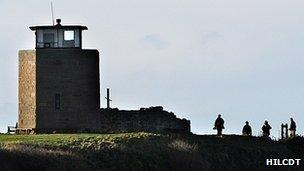Spider web glass protects birds on the Holy Island
- Published

A special glass coating, inspired by spider webs, has been used in the UK for the first time.
A lookout tower at Lindisfarne has installed it to protect the hundreds of species that flock to the island off the north-east coast of England.
The Ornilux glazing reflects ultraviolet light which can be seen by birds but appears invisible to humans.
Tests suggest it can cut bird strikes by about two-thirds, and work is being done to improve it further.
The technology was developed by the German company Arnold Glas.
"A friend of the owner of the company saw an article about the Orb-weaver spider," said the firm's export manager Natalie Kopp.
"Its web reflects UV light protecting it from being destroyed by birds as they can see it and do not fly through. The idea of developing a coating for glass... inspired by nature was born on the same evening.
"Development of the product took some years, and there were many glass and coating types tested before the current Mikado coating was found to be effective."
Mikado is the German name for the game Pick-up sticks. It was chosen because the pattern looks like the sticks after they have been scattered on the ground.
Crash test birds
The firm tested its Ornilux glass at a flight tunnel at a US nature reserve.
Birds were encouraged to fly to the end of the facility which was covered with two types of glass - one containing the Mikado coating, the other without. A net was used and the firm says no birds were injured.
The experiment suggested that the innovation would prevent birds flying into coated glass in 66-68% of all cases.
The safety measure comes at a cost. The product is significantly more expensive than alternative measures such as placing semi-transparent UV-coated stickers across windows.
But it has the advantage that it does not spoil the view for humans.
Stunning views
This was an important factor when the Holy Island of Lindisfarne Community Development Trust wanted to create a "room with a view" at the top of its old Lookout Tower.
The 1940s-built landmark was originally used by the local coastguard and families to watch over the island's fishermen.
It had been disused for many years but was recently given a makeover to provide visitors with views that stretch for tens of miles in different directions out to the seal-inhabited Farne Islands and the Cheviot Hills.
"We have a massive increase in birds at certain times of the year and the building is going to be there permanently," David Suggett, Holy Island development officer told the BBC.
"From the outside to the human eye the glass looks absolutely normal - it just looks like it's see-through.
"But if you are a member of the public and you go inside and you go very close to the glass at a certain angle you can see very fine veins running through it and this is what the birds pick up on when they are flying round the tower."
While Lindisfarne is the first to use Ornilux in the UK, it has already been installed at a wildlife centre in Canada, a zoo in Germany, a mountain railway building in Austria, and a school in the US.
And Arnold Glas says it is working on a next-generation product which aims to add solar controlling properties to the Mikado coating to help reflect heat.
- Published5 June 2012
- Published8 March 2012
- Published28 October 2011